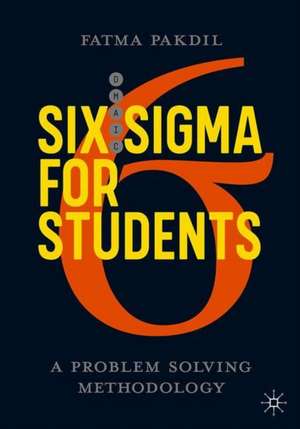Six Sigma for Students: A Problem-Solving Methodology
Autor Fatma Pakdilen Limba Engleză Paperback – 22 dec 2020
Preț: 743.27 lei
Preț vechi: 906.43 lei
-18% Nou
Puncte Express: 1115
Preț estimativ în valută:
142.24€ • 154.45$ • 119.48£
142.24€ • 154.45$ • 119.48£
Carte tipărită la comandă
Livrare economică 23 aprilie-07 mai
Preluare comenzi: 021 569.72.76
Specificații
ISBN-13: 9783030407087
ISBN-10: 303040708X
Pagini: 405
Ilustrații: XXVII, 492 p. 161 illus.
Dimensiuni: 178 x 254 x 33 mm
Greutate: 0.89 kg
Ediția:1st ed. 2020
Editura: Springer International Publishing
Colecția Palgrave Macmillan
Locul publicării:Cham, Switzerland
ISBN-10: 303040708X
Pagini: 405
Ilustrații: XXVII, 492 p. 161 illus.
Dimensiuni: 178 x 254 x 33 mm
Greutate: 0.89 kg
Ediția:1st ed. 2020
Editura: Springer International Publishing
Colecția Palgrave Macmillan
Locul publicării:Cham, Switzerland
Cuprins
I Organization of Six Sigma.- 1. Overview of Quality and Six Sigma.- 2. Organization for Six Sigma.- 3. Cultural Considerations for Effective Six Sigma Teams.- II Six Sigma Process: DMAIC.- 4. Define Phase: D Is for Define.- 5. Measure Phase: M Is for Measure.- 6. Measurement System Analysis: Gage R&R Analysis.- 7. Analyze Phase: A Is for Analyze.- 8. Analyze Phase: Other Data Analysis Tools.- 9. Control Charts.- 10. Improve Phase: I Is for Improve.- 11. Control Phase: C Is for Control.
Notă biografică
Fatma Pakdil is Professor of Management at Eastern Connecticut State University (ECSU), USA. She specializes in organization theory, service quality, quality engineering, total quality management, lean management, and Six Sigma. Dr. Pakdil was previously a professor in the Department of Industrial Engineering at Baskent University, Turkey. Dr. Pakdil was employed for 6 years as the Quality Director in a hospital where she led continuous quality improvement projects. She also worked as a Visiting Professor at Auburn University for Academy of Aerospace Quality (AAQ) Project in 2014 and 2015. Dr. Pakdil was awarded several national scholarships and grants, the most recent one being the CSU-AAUP Research Award awarded to her in 2018 while working at ECSU.
Textul de pe ultima copertă
This textbook covers the fundamental mechanisms of the Six Sigma philosophy, while showing how this approach is used in solving problems that affect the variability and quality of processes and outcomes in business settings. Further, it teaches readers how to integrate a statistical perspective into problem solving and decision-making processes. Part I provides foundational background and introduces the Six Sigma methodology while Part II focuses on the details of DMAIC process and tools used in each phase of DMAIC. The student-centered approach based on learning objectives, solved examples, practice and discussion questions is ideal for those studying Six Sigma.
Caracteristici
Gives students opportunities to practice on examples, practice, and discussion questions Gives students opportunities to take a role as a decision-maker in Six Sigma process Teaches students to apply the tools and methods of Six Sigma in each phase of the DMAIC process using a step by step approach Request lecturer material: sn.pub/lecturer-material
